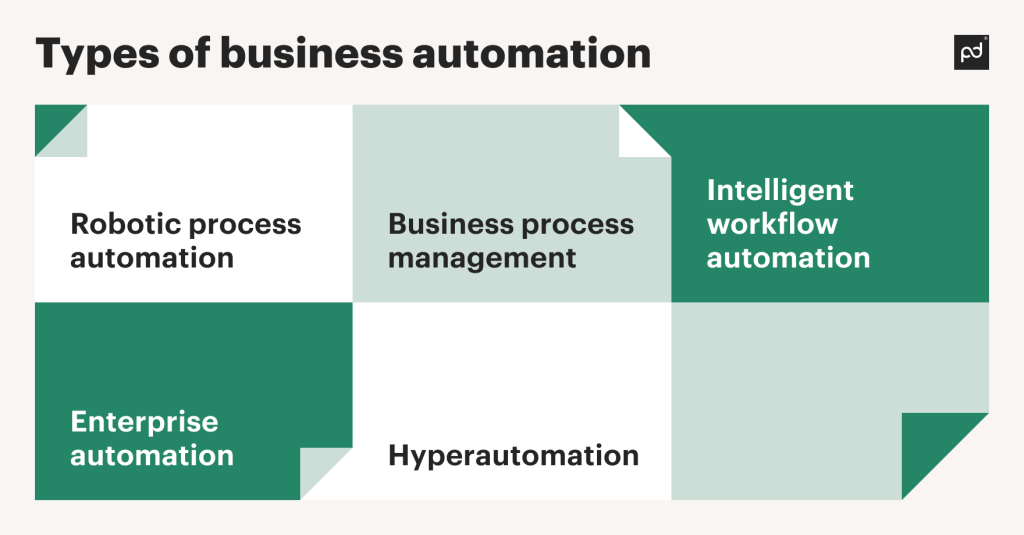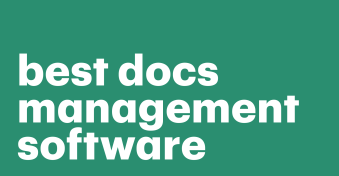Enterprise automation refers to the use of automation technologies to reduce or remove workflow complications, task repetition, and disruptions to business performance — while simultaneously lowering operational expenses.
In this article, we’ll walk you through the stages of creating and implementing a meaningful enterprise automation strategy.
We’ll explore the software tools and methods crucial for enterprise automation to become a useful contribution to your team’s success.
Key takeaways
- Enterprise automation consists of the right mix of technologies: for example, robotic process automation (RPA), business process management (BPM), and AI to coordinate workflows.
- Steps to build a strategy include an audit of existing processes, prioritizing automation areas, choosing appropriate technologies, and creating and implementing a roadmap.
- A culture of continuous data-driven change management and improvement creates an adaptive strategy that evolves with businesses adopting enterprise automation.
- Regular staff training helps teams embrace change, significantly reducing barriers to workflow optimization.

Speaking about automation types, it’s easy to start comparing apples to oranges.
Below, you can find a classification based on scope and complexity, progressing from task-wide to company-wide and beyond.
1. Task-level: Robotic process automation (RPA)
RPA is aimed at the automation of separate tasks within specific departments.
In a practical sense, RPA looks like the usage of virtual assistants for simple, routine tasks.
Developers create special software bots that mimic human actions like clicking or typing and their combinations like invoice processing.
- According to a market analysis report by Grand View Research, the RPA software market has reached $2.3 billion in 2022, with a CAGR expected to be 39.9% between the period from 2023 to 2030. This growth highlights the rising adoption of RPA across industries.
- Another example: Ernst & Young deployed RPA bots to automate the collection of audit evidence and documentation. This significantly reduced the manual work for auditors, with an average 76% decrease in time required for task completion. The RPA implementation saved Ernst & Young over 100,000 hours per year, improving productivity in the auditing process.
- RPA can also perform repetitive, rules-based tasks in various sectors like finance, healthcare, and customer service — for example, automated appointment scheduling and reminders in the healthcare field.
2. Departmental: Business process management (BPM)
Unlike RPA, which focuses on automating repetitive singular tasks, BPM targets coordinating entire workflows within a department.
BPM tools allow businesses to model processes with flowcharts, set rules-based triggers, assign tasks, and track KPIs.
Using special visual configuration tools, you can design a flowchart-like sequence that guides a process from start to finish.
- For example, a lead nurturing workflow could automatically send emails when leads reach certain lifecycle stages. Email content and timing rules can be set upfront. Dashboard reports allow tracking the workflow execution.
- BPM is also in demand. According to the Fortune Business Insights’ Business Process Management (BPM) Market Forecast, BPM will maintain an average CAGR of 12% until at least 2028.
3. Departmental and interdepartmental: Intelligent workflow automation
An advanced form of BPM, intelligent workflow automation leverages AI for decision-making and data structuring.
The key difference from departmental-only BPM is the ability to handle dynamic situations beyond rigid rules by using an extra layer of intelligence that adapts to changing conditions and data patterns.
- AI is quite efficient in terms of automation, with the potential to save 60% to 70% of employee time, as one McKinsey report claims.
- For instance, an AI-driven chatbot could understand customer questions in natural language, analyze ticket history, and suggest solutions.
- Another example: image recognition could extract data from scanned invoices to auto-populate accounting fields.
4. Company-wide: Enterprise automation
Enterprise automation stands as the overarching approach.
It doesn’t limit its focus to a single department but integrates workflows across all domains, from customer service to supply chain management, creating a unified automation strategy.
This approach leverages the technologies we mentioned above — robotic process automation (RPA), business process management (BPM), and intelligent workflow automation — each serving as integral components under the enterprise automation umbrella.
For instance, an order-to-cash workflow system utilizing enterprise automation could seamlessly trigger actions in CRM, ERP, billing, and shipping systems to fulfill orders, with predictive analytics in place to identify and mitigate risks like late deliveries by dynamically adjusting workflows.
5. All-inclusive: Hyperautomation
This is the last, most complex, and most capable type, which can transform the whole business model.
This approach uses the latest technologies, like AI, IoT, blockchain, etc., to continually scan for optimization, identify new opportunities for efficiency, and make the most of them without any human intervention.
For example, a manufacturing plant could have all equipment fitted with sensors that provide data to cloud systems.
AI algorithms then orchestrate the production schedule, optimizing for quality, costs, and timing.
How PandaDoc fits in
PandaDoc doesn’t directly provide task-level automation like RPA or the complex AI-driven capabilities seen in intelligent workflow automation.
However, our platform directly supports categories of departmental automation, accelerating routine document workflows, as well as boosting company-wide enterprise automation thanks to a host of integrations with a variety of CRM and ERP systems.
The enterprise automation advantage, and why your business needs it
Enterprise automation delivers advantages that enhance different areas of a business:
- Efficiency increases by automating repetitive tasks, freeing up employees for more strategic work.
- Costs are reduced through less manual labor and fewer mistakes.
- Accuracy improves since automated systems consistently follow precise algorithms.
- The customer experience gets better with enhanced personalization and faster problem or error resolution.
- Scalability goes up as systems easily adapt to growing workloads.
- Data analytics provides more insights from automated collection.
- Compliance increases when systems automatically follow guidelines.
- Supply chain management is optimized by using real-time tracking and forecasting.
- Products get to market faster by streamlining the development process.
Steps to build an enterprise automation strategy
Implementing enterprise automation is a journey that requires careful planning and execution.
Here are the key steps to build a robust automation strategy for your organization.
1. Conduct an audit of current processes
Start with a thorough documentation of all manual processes.
First of all, form a list of the processes you have to automate.
Then, create detailed process maps and analyze how the work flows through each department to find pain points.
For example, during the mapping out the steps of customer order processing, you should highlight decision points, task hand-offs, and potential bottlenecks.
Visualize workflows using specialized process mapping software. This illuminates automation opportunities.
2. Prioritize areas for automation
With process maps complete, prioritize which parts are ready for workflow automation and which aren’t.
Target repetitive tasks, those prone to human error, or manual work requiring extensive hours.
Another important prioritization criterion is the automation complexity: some workflows require a lot of effort to be automated.
The winning combination will contain those workflows that require a lot of manual jobs yet can be automated with ease.
3. Select appropriate technologies
For each process you’ve prioritized for automation, determine suitable technologies that can address your pain points.
Options include robotic process automation (RPA), artificial intelligence (AI), machine learning, and business process management (BPM) tools.
Key selection criteria will ease integration with your existing systems, scalability, and cost.
Complex processes may need a combination of technologies — if applicable given the limited tech comfort level with your team, consult IT leaders and automation specialists.
4. Create an implementation roadmap
With processes and technologies identified, build and roll out your roadmap.
Start with pilot projects to demonstrate quick wins and raise internal support.
Once everything is ready, start executing your strategy.
During the execution, document metrics like time and cost savings to quantify the benefits of automation.
Gather employee feedback to address their concerns.
5. Utilize data and analytics
Make data central to your automation strategy. Receive data from multiple sources to monitor performance.
Display key metrics on dashboards for real-time visibility.
Leverage analytics and AI to surface insights that inform optimization.
As IBM claims, the use of the Watson Analytics system along with RPA helped the company reduce errors by up to 50%.
6. Continuously improve your enterprise automation
Treat automation as an evolving initiative, not a one-time fix.
Have a governance plan to regularly evaluate and enhance strategy.
Monitor KPIs like task accuracy, output quality, and cycle time. Seek frequent feedback from employees using the solutions.
Look for new automation opportunities as workflows change.
Finally, manage technical debt, be ready to tweak solutions when needs shift, and upgrade systems when beneficial.
Next steps
Enterprise automation is by all accounts a transformative power.
It has the potential to streamline operations, reduce costs, and elevate overall business efficiency.
Start solving your automation challenge by signing up for a PandaDoc trial.
This way you can explore all the features thoroughly to understand if the product fits you well.
Disclaimer
PandaDoc is not a law firm, or a substitute for an attorney or law firm. This page is not intended to and does not provide legal advice. Should you have legal questions on the validity of e-signatures or digital signatures and the enforceability thereof, please consult with an attorney or law firm. Use of PandaDoc services are governed by our Terms of Use and Privacy Policy.


